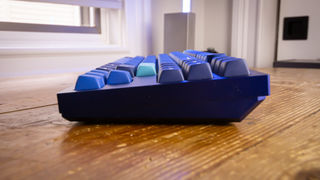Tom's Hardware Verdict
While the Keychron Q3 has all of the features mechanical keyboard enthusiasts desire, the company missed on some key features, like proper sound dampening and flex.
Pros
- +
+ Gasket mount design
- +
+ Durable
- +
+ Rotary knob
- +
+ Screw-in stabilizers
- +
+ QMK/VIA support
Cons
- -
Terrible keycaps
- -
No per-key RGB in software
- -
Steel plate is too heavy
- -
Hollow
- -
Rotary knob placement is awkward
Why you can trust Tom's Hardware
Mechanical keyboards have evolved from bricks with loud solenoid switches to rectangles with hundreds of varieties of switches and keycaps to fit your needs. The issue with the hobby is that it’s very expensive, which is evident in fantastic but expensive planks like the Mode Designs Mode Eighty. Even some of the best gaming keyboards can get pricey with all the bells and whistles included.
This is where boards like the Keychron Q lineup come in. The Q-series offers enthusiast-grade features for affordable prices and is almost constantly in stock. The Keychron Q3, the company's latest, is a tenkeyless, gasket-mount board that ticks all of the boxes when it comes to features but misses some in the typing experience thanks to a stiffer-than-expected feel and hollower-than-expected sound. The Q3 is offered either barebones (starting at $154) or fully assembled with a rotary knob for $184.
Keychron Q3 Specs
| Switches | Gateron G Pro Brown |
| Lighting | Non-addressable |
| Onboard Storage | 5 profiles |
| Media Keys | Rotary knob or configurable |
| Connectivity | USB Type-C |
| Cable | 6 feet, braided |
| Additional Ports | None |
| Keycaps | Doubleshot PBT |
| Software | QMK, VIA |
| Dimensions (LxWxH) | 365.1 x 137 x 38.1mm |
| Weight | 2.5 pounds |
Design for the Keychron Q3




The Keychron Q3 is a tenkeyless (TKL), gasket mount mechanical keyboard that comes with an aluminum chassis, sound-dampening foam, screw-in stabilizers, double-shot PBT keycaps, a rotary encoder, hot-swap PCB, adjustable RGB lighting, Windows and Mac support and QMK/VIA software support.
Gasket mount boards utilize foam pads, which are placed on the top and underneath the switch plate. By doing this, the foam pads provide enough structural integrity, eliminating the need for screws, while providing a more uniform sound and a comfortable amount of flex. However, the Q3 fell short in my tests because the typing feel wasn't as responsive as we expect from a quality, gasket-mount keyboard and the sound was just hollow.
When I reviewed the Keychron Q2, I was very impressed as the board seemingly addressed all of my issues with its predecessor, like the hollow case, lack of flex, and ticking stabilizers. However, it seems like the company back-peddled with the Q3.
The first thing I noticed when I took the Q3 out of the box was the rotary knob, which looks very weird. The knob is placed where the F13 key would normally sit, and while it’s not the worst spot, it’s definitely not a great one. I would’ve preferred to see the knob located at the top right, where the pause / break key would be, because who actually uses that anymore? Now, this board is also available in a knobless version and, if you’re into soldering, the rotary encoder can be desoldered for a standard MX switch.
At just under four and a half pounds (2 kg), the Q3 is heavy, but its weight doesn’t improve acoustics, which is usually the case for other enthusiast-tier mechanical keyboards. Mechanical keyboard enthusiasts like to spend extra for their board by purchasing weighted bars to help dampen noise. This is most evident in many of KBDFans’ boards, like the KBD75, which has a cutout on the backplate for weighted bars, typically made of brass.
Since the Q3 is a big and heavy board, the aluminum case sounds extremely hollow, which surprised me since there’s foam between the PCB and switch plate, as well as underneath the PCB, along with silicone tabs on the bottom plate.
Reviewing the Q3 made me wonder why there aren’t many gasket-mount TKL keyboards. My initial thought was weight, but you can always get a light switch plate, like FR4. Instead, Keychron opted to use a steel plate, which is far too heavy for a TKL gasket-mount board.
I use the Q2 (65%) as my daily driver and I tend to forget that it too has a steel switch plate because it had much more flex even prior to removing some screws. I’ll discuss this more in the typing experience, but while this board is far from being unpleasant, the gasket-mount implementation feels lackluster.
One of the biggest complaints I had with the previous Q-series boards (and Keychron's K8 Pro) was the subpar quality of the keycaps, and this trend continues with the Q3. The keycaps are printed very poorly, especially on the backspace key, which says “backs pace” with a gap between the characters. You still get double-shot PBT keycaps with an OSA profile if you can look past the awful printing.
While mechanical keyboard enthusiasts have been leaning towards clip-in stabilizers for ease of access, screw-in stabilizers still perform better than most plate-mount stabilizers, and that’s what Keychron went with. One of the things I praised the Q2 for was the improvement of its stabilizers, but it seems like Keychron went back to the stabilizers from the Q1 because these things tick and rattle a ton, even with the decent amount of lube they come coated in. If you’re interested in addressing this issue, we have a guide on some mods you can do to your stabs, amongst others, for your Q3 or any mechanical keyboard.
As with all Q-series boards, you get the switch in front of the case to toggle between Windows or Mac and a USB Type-C port. Also, like the rest of the lineup, you get QMK and VIA support instead of the bloated, half-baked remapping software some keyboard manufacturers use.
Almost all keyboards nowadays connect via USB Type-C, and the Q3 is no exception. The included cable has USB Type-C connectors on both ends, but Keychron also includes a Type-C to Type-A adapter. The cable matches the royal blue case extremely well, and the sleeving quality is solid.
Typing Experience on the Keychron Q3
Before I started typing with the Q3, I was expecting a boatload of bounce, because that’s what I got with the Q2 after the company improved its gasket-mount design. However, the amount of bounce felt like nothing more than subtle taps.
Three flavors of switches are offered with the Q3: Gateron G Pro Red, Brown or Blue.. Our review sample came with Browns, which I’ve never been a fan of because, to me, they feel like a linear switch trying to decide whether or not it wants to be tactile. However, I have always been a fan of the Gateron G Pro line of switches because they have almost no stem wobble.
Since the PCB is hot swappable on the Q3, I wanted to see if I could get this board to flex a bit more by using the heaviest switch I had on hand, my NovelKeys Cream Arc switches. The Cream Arcs are linear switches that use progressive springs, which have an operating force of 75 grams and a bottom-out of a whopping 120 g. As it turns out, my experiment worked and the heavier than usual linears did increase the flex a decent amount.
I really like the OSA (OEM spherical angled) keycaps. The rounded top made my fingers feel like they were being cradled. The company also sent a set of its double-shot ABS keycaps for me to try, and I think they look way better than the OSA ones.
Gaming Experience on the Keychron Q3
In 2022, some of the best gaming keyboard companies have tried to implement features like overwhelmingly high polling rates and switches so light that a subtle gust of wind will actuate them. The Keychron Q3 isn’t a gaming keyboard, so it's unsurprising that it doesn't offer any of those features. However, I am a gamer, so I wanted to test it.
One of my favorite first-person shooters, the original Call of Duty: Modern Warfare, still has populated servers, so I edited my class and booted up. Since Modern Warfare was released in 2007, my PC could get over 144 frames. With that frame rate advantage, I got a bit competitive.
I needed to be able to strafe as fast as possible, and the 45 g weight of the Gateron G Pro Browns was perfect for bridging the gap between too light and too heavy.
Software for the Keychron Q3

I always say it, and I’ll repeat it – VIA is the best keyboard software because of its ease of use and library of features. However, the Q3 is a TKL, so almost every key you need is preconfigured, even scroll lock.
While I’m not a fan of the location of the rotary knob, it’s still a rotary knob and with the support of VIA, you can do almost anything with it. Instead of using the knob for volume control, I configured it to adjust my monitor's brightness. I also replaced the dedicated voice assistant key to put my PC into sleep mode and F1-F2 for RGB brightness control.
The Q3 supports up to four profiles, which is a good number, especially with a TKL with many keys. However, this board falls short compared to the Q2, which supports five layers. This is nitpicking, but I couldn’t ignore it.
VIA and QMK offer a lot of RGB adjustments, like hue, saturation and brightness, it isn't offered on a per-key basis.
Bottom Line

I am quite disappointed in the Q3, especially with how fantastic the Q2 is. However, for $184 (rotary knob version), you still get a gasket-mount mechanical keyboard with many customization options. For $20 less, you can get the Q3 in its barebones form with the rotary knob. The Q3 is also available without a rotary knob at $174 fully and $154 barebones (without keycaps or switches). If you insist on having a rotary and love the TKL layout, this may be for you, though that knob is in a very odd place.
Keychron pulled its punches on the typing experience; the hollowness from the chassis and lack of flex when typing was surprising. This isn't a bad keyboard, but Keychron has made better ones, and I would really like to see it move from strength to strength no matter what size board it's selling.

Myles Goldman is a freelance writer for Tom's Hardware US. He reviews keyboards and cases.

Microsoft is switching RAM speed units in Task Manager — finally moving to the more technically correct MT/s

Pre-Memorial Day Sales 2024: Save on gaming laptops, CPUs, monitors and more

Lenovo ThinkPad P1 Gen 7 is the world's first laptop to sport LPCAMM2 memory — more compact, higher performance, lower power
